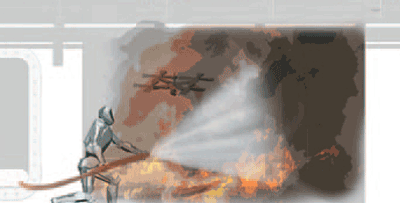Soon, autonomous shipboard humanoids will present themselves on Navy ships to fight fires.
Dennis Hong, profossor of mechanical and materials science at Virginia Tech and director of the Robotics and Mechanisms Laboratory is working with fire expert Brian Lattimer, the University of Pennsylvania, and the Office of Naval Research to create a robot that will enter the dangerous environments of ship fires and extinguish them.

Autononmous shipboard humanoid, ASH. (Image via Robotics and Mechanisms Laboratory)
The autononmous shipboard humanoid, also called ASH, will be able to sense through the smoke without being affected by the heat or lack of visibility and will make its own decisions without waiting for human intervention and instruction.
Hong’s robotics team is designing and constructing the actual robot, while Lattimer is applying his fire expertise to its sensor and control technologies.
In the instance of fighting fires on naval ships, it is necessary to use a humanoid robot with fluid, human-like movements because of the ship’s design that may require limb interaction to navigate through doors and passageways. Ships are built for humans and sometimes require actions such as pulling or pushing handles or bars, but in instances where it is dangerous for humans, ASH will come to the rescue.
The teams are working to grant ASH unique walking capabilities that will allow it to tread any surface since fires often change the structure’s terrain causing holes in the floor or cluttered pathways. Also, don’t forget that a ship is on the sea creating a constant rocking motion that the robots will have to battle.
Hong will be using compliant linear actuator technology on the robot, allowing ASH to walk, balance, and even run, regardless of the floor’s surface.
ASH will not be designed to go at it alone though. Humanoid robots, and eventually many of them, will gear up in standard human fire suits, partner with human firefighters and communicate via standard emergency hand signals in the case of a ship fire.

Artistic drawing of a robot fighting a fire. (Image via Virginia Tech)
Challenges
The main challenges at hand are creating the robot to move easily through a ship and communicating with the humans, but other challenges include designing the robot armed with sensors and infrared cameras that will allow it to navigate through the zero-visibility conditions a fire presents.
ASH’s bottom half is already complete, and the groups are working to finish its top before the end of the year. They will then begin testing the robot early next year on a ship in Alabama.
The group hopes to have the ASH and fellow fire-fighting robots functional and ready to serve by 2020.■
Story via Virginia Tech
Advertisement
Learn more about Electronic Products Magazine





